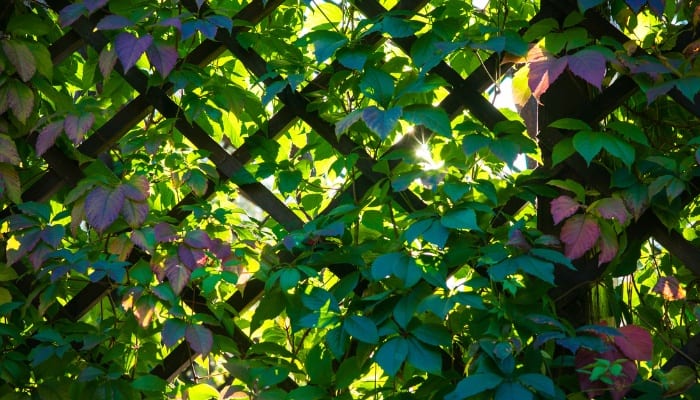Officially known as Parthenocissus quinquefolia, Virginia creeper is a type of plant in the grape family that grows in North America, from Canada to Mexico.
It can climb on all types of surfaces thanks to its tendrils padded with an adhesive-like substance. This climber averages 70 to 100 feet tall at maturity.
Why is my Virginia creeper dying? If your Virginia creeper is dying, chances are you have a pest infestation in the garden. Fungus and disease also account for the demise of the climber. Inadequate watering is another reason. If you have used a herbicide near the plant, that could kill it.
With so many reasons for the plant’s premature death, you’ll need to investigate each case closely and find a remedy to fix it. Read more to find out what to do about your dying Virginia creeper.
6 Reasons Why Your Virginia Creeper Is Dying
More often than not, a dying Virginia creeper has been attacked by pests that damaged its structure, eaten through the surface of the leaves, and probably caused severe damage to the vines, but that’s not the only reason.
Here are the 6 most common causes of a dying Virginia creeper.
1. Pest Damage
The juicy and tender leaves of Virginia creeper attract a lot of insects. Some of them are so voracious that they could strip the vine of most of its leaves in a matter of days.
If you don’t intervene, the vine won’t be able to photosynthesize sunlight and generate plant energy, which leads to its premature death. The most common pests that attack the Virginia creeper are the following:
- Weevil
- Scale
- Leafhopper
- Japanese beetle
- Leaf-cutting bee
- Caterpillar
- Aphids
Solution
Each one of those pests has a different way to approach it. For aphids, you can just hose them off with a strong stream of water.
For scale bugs, caterpillars, and leafhoppers, spray the vine with neem oil, a natural pesticide that kills the pests but doesn’t harm the plant or the environment.
Pick any flea beetles by hand, and drown them in a bucket full of soapy water. As for the leaf-cutting bees, you can wrap the vine with cheesecloth to keep them off.
2. Watering Issues
On average, the Virginia climber needs about 1 inch of water per week. If you overwater it, the roots will rot as the plant doesn’t like to sit in soggy soil.
On the other hand, if you neglect to water the vine regularly, especially in the summer months, drought can prove to be detrimental to the vine.
Solution
Regular watering is the key to the success of the Virginia creeper. During the growing season, allow the top 3 inches of soil to dry out before watering the vine deeply.
If you forget to water it and the plant wilts, water it immediately. Cut back on watering in the fall and winter when the plant goes dormant. Water it once every 2 to 3 weeks.
3. Planted Outside of Its Hardiness Zone
Although the vine is native to North America, it only grows in Zones 3 to 9. This is why you only see it in certain parts of the United States. If you plant it in Zones that are either too cold or too hot, the plant will not survive.
Solution
Make sure that your microclimate is suitable for the Virginia creeper. If you live in Zones 3 to 9, the vine will grow and thrive in the garden.
4. Sprayed With Herbicide
As most gardeners know, herbicides can do more harm than good. While they will kill the weeds and other unwanted plants that grow in the garden, they can also kill the veggies and fruits.
If you’re not careful when applying those herbicides, you could lose most of the plants in the garden.
Solution
Pay attention to the direction of the wind when spraying herbicides. Keep the nozzle of the container close to the spot you want to spray. Always apply on a dry and calm day.
Don’t spray the plants on a rainy day or when you expect rain. The rain could wash the herbicide toward the Virginia creeper.
5. Fungus
Fungal infections can be another reason the Virginia creeper is dying. The fungus causes various diseases and some of them can be fatal.
Solution
Treat fungal infections with a fungicide. You’ll need to identify the fungal infection first before applying the appropriate fungicide. For more details on these fungal infections, see below.
6. Disease
Diseases can be caused by viruses, bacteria, or fungal spores. The Virginia creeper is prone to the following diseases:
- Root rot: Caused by overwatering and leads to yellowing leaves and wilting vines.
- Leaf spot: Black and brown spots appear on the leaves and then merge to form large patches.
- Anthracnose: Lesions form on the vines and cause the leaves to drop.
- Canker: This disease delays new growth in the spring and impacts the foliage of the vine.
- Powdery mildew: Another fungal infection that coats the leaves with a white powder.
Solution
Water the vine regularly and allow the top 3 inches of the soil to dry out between irrigations to prevent root rot. As for leaf spot and powdery mildew, you’ll need to apply a lime sulfur spray on the dry leaves.
With Anthracnose and canker, spray the Virginia creeper with a copper fungicide. Follow the instructions on the package for each spray. Cut off the infected leaves, and destroy them.

Virginia Creeper Care
The Virginia creeper is easy to care for. The hardy climber grows in different types of soil and doesn’t need fertilizing.
If the plant has a slow growth rate, apply a thin layer of compost in the spring. Use mulch to improve moisture retention and prevent pests from reaching the vine.
Water regularly and deeply allowing the top 3 inches of soil to dry out between irrigations. Don’t forget to cut back the vine when it goes dormant.
When To Cut Back Virginia Creeper
In the winter, the Virginia creeper sheds its leaves and goes dormant. This is the best time to cut back the vine. This allows you to manage its size and shape and encourages new growth in the early spring.
Controlling Virginia Creeper
The best way to control the Virginia creeper is to prune it regularly and cut it back hard in the winter. As long as the plant is dormant, you can cut it back as much as you like since it will grow back in the spring.
Related Questions:
Is Virginia Creeper Invasive?
Virginia creeper is an invasive plant that tends to crowd out other plants and claims every inch of available space in the garden. It uses its tendrils that are padded with adhesives to climb over smooth surfaces and spread out.
Is Virginia Creeper Evergreen?
Virginia creeper is a deciduous climber. It sheds its leaves in the later fall or early winter depending on your growing zone.
Conclusion
If your Virginia creeper is dying, check for pest infestations, fungi, and diseases. Watering either too much or too little can also disrupt the vine’s growth and cause it to die early. The climber grows best in Zones 3 to 9, so make sure you live in one of those Zones to ensure its success.

